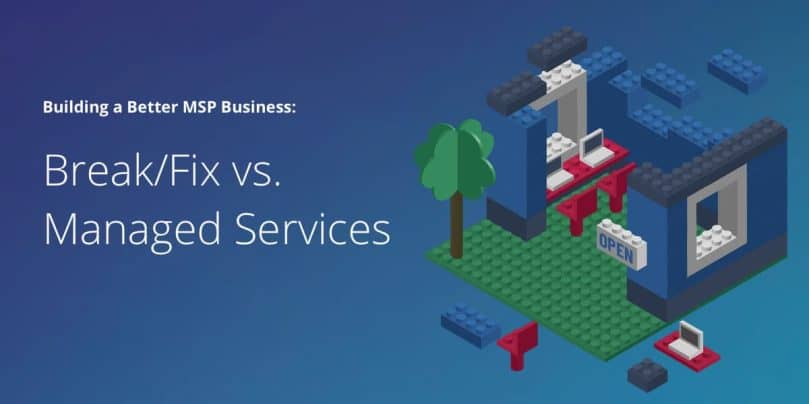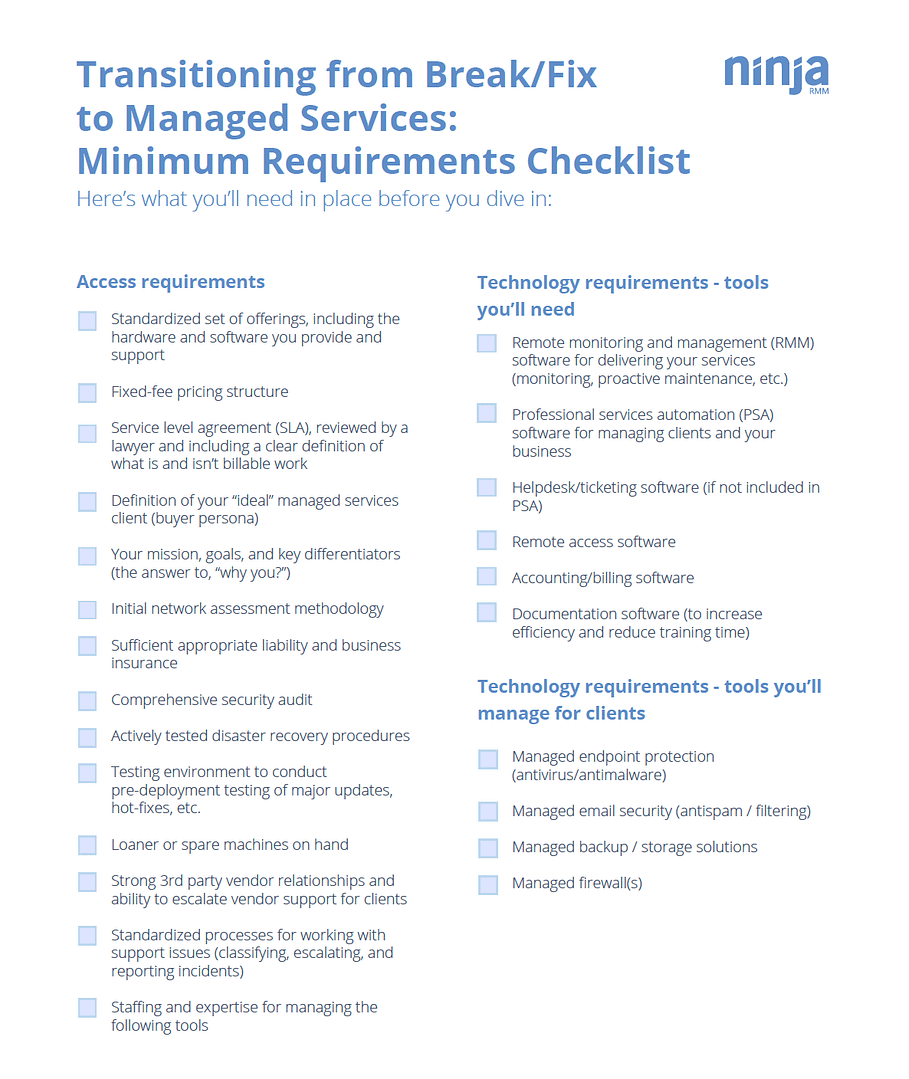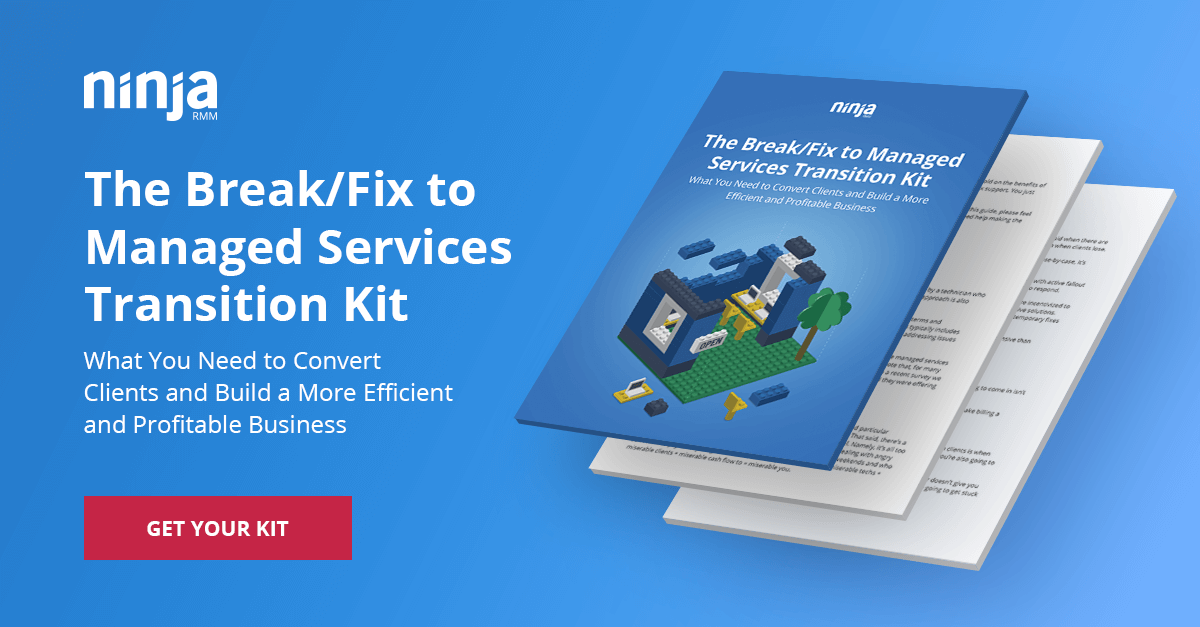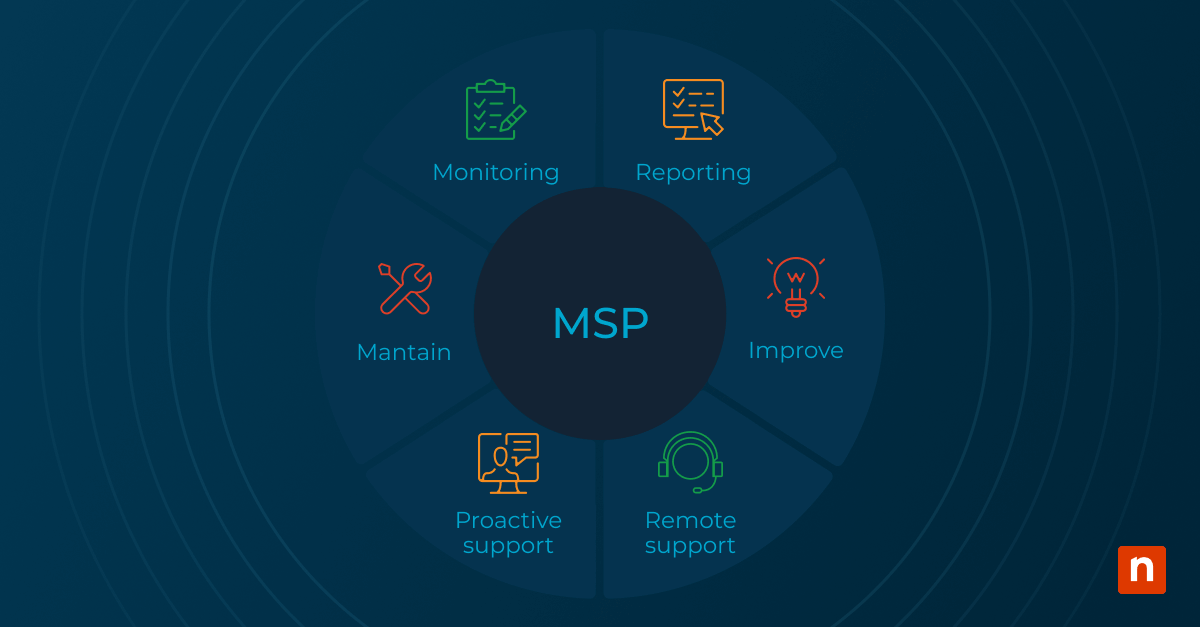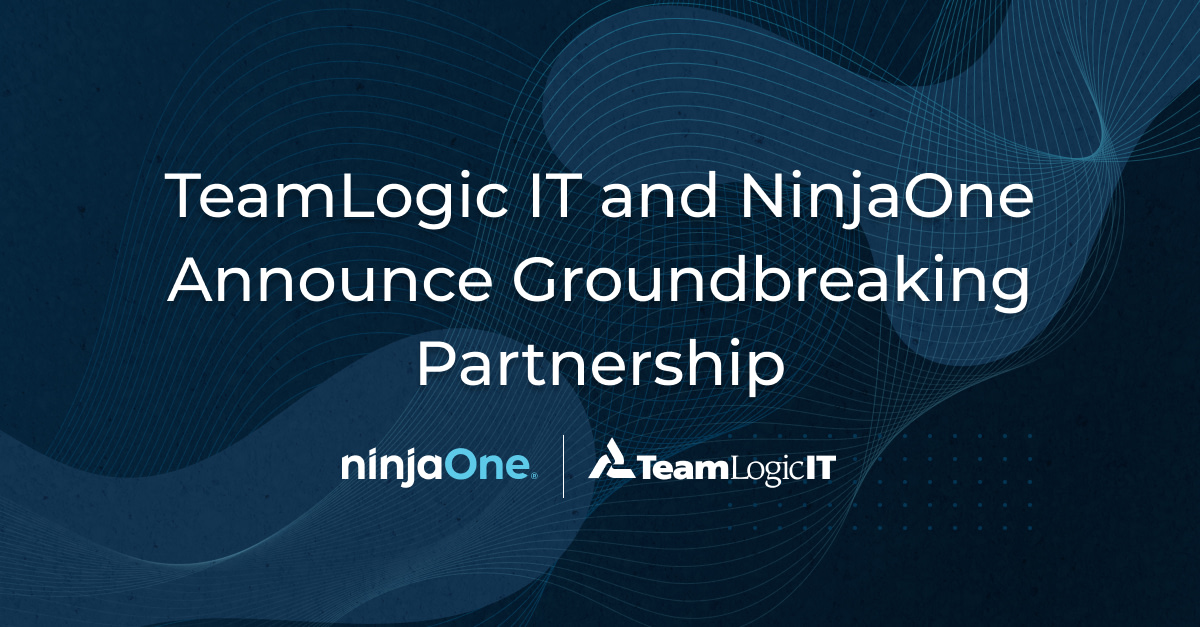Note: The following is an excerpt from The Break/Fix to Managed Services Transition Kit, which includes a 4-step action plan for making the switch to managed services along with bonus templates and tools you can use to get started right away.
What’s the difference between break/fix support and managed services?
With break/fix support, IT services are provided as requested, typically by a technician who resolves issues on-site. The client is billed for time and materials. This approach is also referred to as fee-for-service.
With managed services, the provider offers more holistic IT support — terms and conditions of which are detailed in a service level agreement (SLA). This typically includes proactive monitoring and maintenance done remotely with the goal of addressing issues before they become client-facing problems and system failures.
There has been a large and steady migration away from break/fix to the managed services model for years, for reasons we’ll get into below. That said, it’s important to note that, for many providers, break/fix support does still have a role in their business. According to a recent survey we conducted with over 400 IT services providers worldwide, 71% reported they were offering a combination of managed services and break/fix support.
Problems with the break/fix model
Break/fix servicing may actually be the right model for certain clients and particular situations. Under the right conditions, it can be effective and profitable. That said, there’s a reason managed services has emerged as the dominant business model. Namely, it’s all too easy for break/fix models to create situations where you’re constantly dealing with angry clients in crisis mode who have a penchant for ruining your nights and weekends and who don’t want to pay for anything. At its worst, it’s a recipe that combines miserable techs + miserable clients + miserable cash flow = miserable you.
Here are a few of the fundamental flaws in the break/fix model.
Why the break/fix model can be bad for clients:
- Misaligned incentives and goals: Service providers only get paid when there are problems. That creates an oppositional dynamic where they win when clients lose.
- Unpredictable costs: Because break/fix work is reactive and case-by-case, it’s difficult for clients to budget ahead of time.
- Burden is on them to know what needs to be done: The break/fix model requires clients to be the decision makers, even if that’s not a position they’re qualified for or want to be in.
- Downtime: The reactive nature also means clients have to deal with active fallout from problems while they alert the provider and wait for them to respond.
- Short-sighted: Because work is billed hourly, break/fix clients are incentivized to choose quick, short-term fixes over long-lasting but more intensive solutions. Likewise, break/fix service providers are incentivized to provide temporary fixes again and again instead of solving issues for good.
- Ultimately more expensive: Remediation is always more expensive than prevention.
Why the break/fix model can be bad for IT service providers:
- Unpredictable revenue: Not knowing when the next job is going to come in isn’t exactly ideal.
- Complicated billing: The case-by-case nature of the work can make billing a time-consuming negotiating battle for every job.
- You’re not calling any shots: You’re depending on the client to assign and approve work, which typically doesn’t happen until disaster strikes and you get angrily called in to clean up another mess.
- High stress: Working in a perpetual state of crisis takes its toll.
- Poor client relationships: If the only time you’re interacting with clients is when stuff breaks not only are they not going to be happy to see you, you’re also going to dread seeing or hearing from them.
- Fewer career growth opportunities: Being a full-time firefighter doesn’t give you much time to learn new technologies or pick up new skills. You’re going to get stuck mastering the bare minimum necessary to get through your day.
Benefits of the managed services model
The managed services model is a proactive alternative that solves for many of the issues with the break/fix approach.
Pros for clients:
- Better alignment: Managed services providers (MSPs) are incentivized to spend less active time cleaning up messes, so instead they aim to prevent problems in the first place — the same goal the client has!
- Predictable costs: Set monthly fees give clients budget clarity.
- Better stability: Because MSPs provide 24/7 monitoring and proactive maintenance they’re able to quickly respond to issues and head off potential system failures before damage is done.
- Infrastructure upgrade: Rather than simply applying band-aids, MSPs provide clients with more robust and secure IT environments by managing network performance, security, backup, email, helpdesk, and more.
- More affordable than in-house IT: With an MSP, clients get many of the same dedicated capabilities at a fraction of the cost of a full-time team.
Pros for IT service providers:
- Predictable revenue: Being able to count on a steady stream of monthly recurring revenue makes your life much, much easier.
- You’re in the driver’s seat: No more haggling with clients every time you want to do a job or make an improvement. With your flat rate and SLA you commit to achieving a certain level of service whatever way you see fit.
- Streamlined billing: No more dealing with a mountain of complex, one-off invoices, either. Just simple flat-fee invoices issued at the beginning of every month.
- Way less firefighting: Thanks to proactive maintenance you’ll have far fewer panicked calls waking you up in the middle of the night. You’ll have the freedom to do things right and create a more stable network that’s less of a pain and liability to manage.
- Better client relationships: Your relationship with clients can evolve into more of a true partnership with a focus on your services adding value instead of being purely a cost and a commodity.
- It makes your business more valuable: Investors love recurring revenue. It makes your company’s financials more predictable, measurable, and scalable.
Thinking of transitioning from break/fix to managed services? Here’s a checklist.
Making the switch from break/fix to managed services isn’t a light undertaking. To help you understand what’s involved here is a checklist of core things you’ll need to have in place before you take the plunge. Click the image of the checklist below to download the checklist as a PDF.
If you’re looking for actionable advice on making the switch check out our Break/Fix to Managed Services Transition Kit. It provides a 4-step action plan you can follow PLUS some additional templates/tools that can give you an easy jumpstart.

